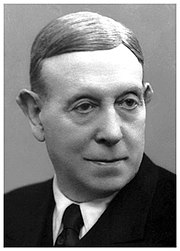António Egas Moniz
| António Egas Moniz | |
|---|---|
 |
|
| Born | António Caetano de Abreu Freire Egas Moniz 29 November 1874 Avanca, Estarreja, Portugal |
| Died | 13 December 1955 (aged 81) Lisbon, Portugal |
| Nationality | Portuguese |
| Fields | Neurologist |
| Institutions | University of Coimbra (1902); University of Lisbon (1921–1944) |
| Alma mater | University of Coimbra |
| Known for | Prefrontal leucotomy, cerebral angiography |
| Notable awards | Nobel Prize in Physiology or Medicine, 1949 |
| Spouse | Elvira (1884-1955) |
António Caetano de Abreu Freire Egas Moniz (29 November 1874 – 13 December 1955), known as Egas Moniz (Portuguese: [ˈɛɣɐʒ muˈniʃ]), was a Portuguese neurologist and the developer of cerebral angiography. He is regarded as one of the founders of modern psychosurgery, having developed the surgical procedure leucotomy—known better today as lobotomy—for which he became the first Portuguese national to receive a Nobel Prize in 1949 (shared with Walter Rudolf Hess).
He held academic positions, wrote many medical articles and also served in several legislative and diplomatic posts in the Portuguese government. In 1911 he became professor of neurology in Lisbon until his retirement in 1944.
Moniz was born in Avanca, Estarreja, Portugal, as António Caetano de Abreu Freire Egas Moniz. He attended Escola do Padre José Ramos and Colégio de S. Fiel dos Jesuítas and studied medicine at the University of Coimbra, graduating in 1899. For the next 12 years, he served as a lecturer for basic medial courses at Coimbra. In 1911, he became a neurology professor at the University of Lisbon, where he worked until his retirement in 1944.
Politics was an early passion for Moniz. He supported a republican government, diverging from his family’s support for the monarchy. As a student activist, he was jailed on two separate occasions for participating in demonstrations. While serving as Dean of the Medical School at the University of Lisbon, he was arrested a third time for preventing police from settling a student-run protest.
Moniz’s formal political career began when he was elected to parliament in 1900. During World War I, he was appointed the Ambassador to Spain, and afterward, he served as Minister for External Affairs, representing Portugal at the 1918 Versailles Peace Conference.
In 1926, at age 51, Moniz retired from politics and returned to medicine full-time. He hypothesized that visualizing blood vessels in the brain with radiographic means would allow for more precise localization of brain tumors. During his experiments, Moniz injected radiopaque dyes into brain arteries and took X-rays to visualize abnormalities. In his initial tests, Moniz used strontium and lithium bromide in three patients with a suspected tumor, epilepsy, and Parkinsonism, but the experiment failed and one patient died. In the next set of trials, he achieved success using 25% sodium iodide solution on three patients, developing the first cerebral angiogram.
...
Wikipedia
